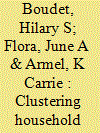|
|
|
Sort Order |
|
|
|
Items / Page
|
|
|
|
|
|
|
| Srl | Item |
| 1 |
ID:
150457


|
|
|
|
|
| Summary/Abstract |
Research on household energy conservation often categorizes targeted behaviours by their behavioural attributes (e.g., savings, cost, frequency). The most common distinction in the literature divides behaviours as follows: (1) low-impact, low-cost, repetitive behaviours that result in a loss of comfort or curtailment behaviours and (2) high-impact, high-cost, infrequent behaviours that result in no loss of amenities or efficiency behaviours. However, such categorizations have often been ad hoc and two-dimensional (e.g., low-impact vs. high-impact, low-cost vs. high-cost). In contrast, we systematically assess a large range of household energy-saving behaviours (N=261) across nine attributes – energy savings, cost, frequency of performance, required skill level, observability, locus of decision, household function, home topography, and appliance topography. By clustering behaviours according to these attributes, we discern four clusters of energy-saving behaviours: family style, call an expert, household management and weekend project. We discuss the implications of these clusters for intervention design.
|
|
|
|
|
|
|
|
|
|
|
|
|
|
|
|
| 2 |
ID:
169849


|
|
|
|
|
| Summary/Abstract |
Population migration embodies virtual residential energy consumption and carbon transfer from the origin to the destination. Based on the differences of the per capita levels between the sending-out origins and arriving-in destinations, we develop a model to estimate the inter-spatial transfer flows of residential carbon emissions, broken down by rural-to-urban, rural-to-rural, urban-to-rural and urban-to-urban flows. The net value of transfer-in and transfer-out residential carbon emission contributes to the change of the whole carbon emission. Using the latest census data and energy balance sheet in 2010, China's inter-provincial residential carbon emission flows embedded in the population migration were calculated and visualized. We found that China's non-Hukou migration increased the national total residential carbon emission. The largest transfer flows were mainly from central to eastern China. The northern provinces were also distinct destinations due to the high-carbon energy structure. The regional difference of residential energy consumption structures, the unbalanced regional economic development and origin-to-destination interaction were the main influencing factors. To promote low-carbon and environment-friendly urbanization, the energy optimization policy should be enhanced in the identified regions, especially in the Beijing-Tianjin area.
|
|
|
|
|
|
|
|
|
|
|
|
|
|
|
|
| 3 |
ID:
125442


|
|
|
|
|
| Publication |
2013.
|
| Summary/Abstract |
Residential energy conservation is a key component of contemporary energy and climate change policy in the US and elsewhere. Comparisons of the relative effectiveness of measures aimed at reducing residential energy consumption are made challenging, however, by the endogeneity of technology and energy use decisions. In this paper we describe a novel small-scale field experiment that uses randomized treatments to estimate the returns to three types of energy conservation measures in institutionally owned homes. The results from the experiment indicate considerable reductions in natural gas consumption associated with the installation of attic insulation and the provision of incentives for conservation. The results are supported by observations of ambient indoor temperature data, which show that households receiving incentives significantly reduce their temperature settings-especially when coupled with access to a programmable thermostat. The study will ideally provide guidance for institutions and communities considering energy efficiency measures and for future researchers designing randomized experiments to study residential energy use.
|
|
|
|
|
|
|
|
|
|
|
|
|
|
|
|
| 4 |
ID:
099241


|
|
|
|
|
| Publication |
2010.
|
| Summary/Abstract |
Residential energy consumption accounts for 22% of the total energy consumption in the US. However, the impacts of local planning policies, such as increasing density and changing the housing type mix, on residential energy consumption are not well understood. Using Residential Energy Consumption Survey Data from the Energy Information Administration, quantile regression analysis was used to tease out the effects of various factors on entire distribution on the energy consumption spectrum instead of focusing on the conditional average. Results show that while housing size matters for space conditioning, housing type has a more nuanced impact. Self-reported neighborhood density does not seem to have any impact on energy use. Furthermore, the effects of these factors at the tails of the energy use distribution are substantially different than the average, in some cases differing by a factor of six. Some, not all, types of multifamily housing offer almost as much savings as reduction in housing area by 100 m2, compared to single family houses.
|
|
|
|
|
|
|
|
|
|
|
|
|
|
|
|
|
|
|
|
|